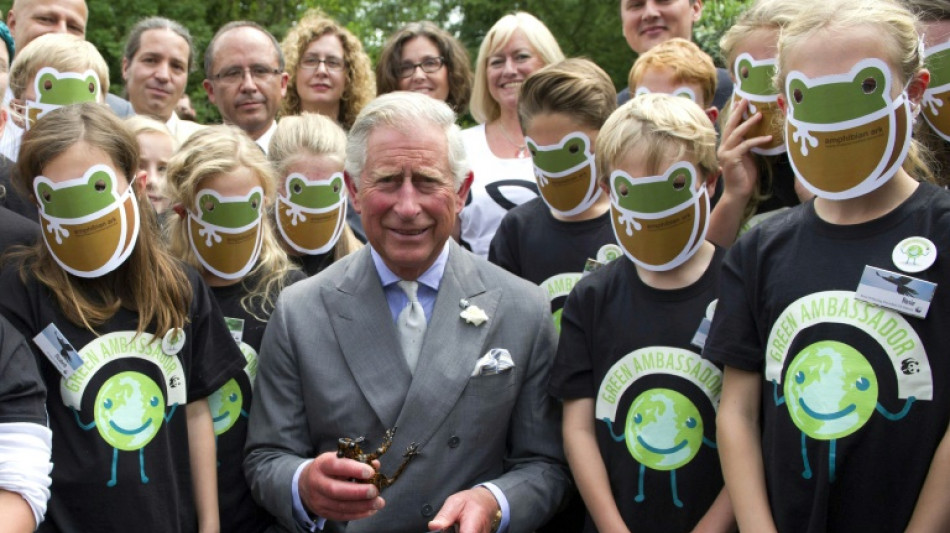
SCS
0.2300

King Charles III, once mocked as a crank for admitting he talked to plants and championing organic farming, has steeped his coronation in symbols of nature and the environment.
As an environment radical long before Greta Thunberg castigated world leaders for "30 years of blah, blah, blah", green issues from climate change to biodiversity have been at the heart of Charles's work.
Now, for his coronation, his environmental interests will be reflected in wildflower seeds for schoolchildren, recycled royal garments, even the possible replacement of tiaras with floral headdresses.
With the UK having lost 98 percent of its wildflower habitats over the past 80 years, primary schools nationwide are to receive 200,000 packets of seeds for children to scatter in their green spaces.
The initiative aims to foster a connection to nature and help children understand how it can support their mental health.
Biodiversity enthusiast Charles has a four-acre (1.6-hectare) wildflower meadow at his Highgrove home in Gloucestershire, western England.
Carefully tended over the past 30 years, it is now home to 120 different plant species and is said to literally hum to the sound of insects and birds.
- Recycling -
As befits a committed recycler whose Aston Martin car runs on biofuel made from surplus English white wine and whey from cheese manufacturing, all of the garments worn by Charles on Saturday will have been previously worn by other monarchs.
The king is well known for having his own clothes patched and mended when they show signs of wear and tear rather than throwing them away.
Last year he signalled his fondness of "make do and mend" by appearing in a special episode of the BBC's hit television show The Repair Shop.
Jay Blades, who presents the programme in which people bring cherished items to be restored by specialists, is among the few to have bagged a coveted invitation to the ceremony.
Although some coronation garments are always used, the decision not to have any new pieces made for his own crowning was a "personal" one made by Charles, according to a royal official.
"It's all in keeping with this idea of sustainability and efficiency to re-use these pieces," Caroline de Guitaut, deputy surveyor of the King's Works of Art, said.
This royal recycling will see Charles wear his grandfather George VI's Colobium Sindonis, a simple white tunic, worn immediately after the anointing of the new king and which symbolises purity before god.
In addition, he will also sport the Supertunica -- a long gold-sleeved robe created for the coronation of George V in 1911 -- the sword belt and white coronation glove.
- Bees and insects -
The coronation robe worn by Charles’s wife Queen Camilla as she leaves Westminster Abbey will also feature designs inspired by nature and the environment.
Bees, a beetle and other insects make an appearance, embroidered in gold on the garment's purple velvet train.
Also embroidered onto the train will be a number of plants including Lily of the Valley -- a favourite flower of the late Queen Elizabeth II -- Myrtle, representing hope, and Delphinium, one of keen gardener Charles's favourite flowers.
The Cornflower, which helps to attract and encourage wildlife such as bees and butterflies, is also featured, as does Maidenhair Fern, a symbol of purity, and Alchemilla Mollis, known as Lady's Mantle, symbolising love and comfort.
The Anointing Screen, which shields the king from view during what is considered the most sacred part of the ceremony, has also been embroidered using sustainable practices.
The design shows a tree with birds and 56 leaves representing the 56 member countries of the Commonwealth which Charles heads.
- Flower power -
The "green" tone for the coronation was set from the invitation to the 2,000 or so guests expected at Westminster Abbey.
It features the Green Man, an ancient figure from British folklore symbolising the arrival of spring and rebirth.
Heraldic artist and manuscript illuminator Andrew Jamieson's design also shows a crown of leaves of oak, ivy and hawthorn, British wildflowers and wildlife.
And the natural world themes could even displace the tiaras traditionally worn by royal princesses to major royal events.
Charles's daughter-in-law Catherine, whose husband is heir to the throne Prince William, is reported to be thinking of wearing a floral headpiece.
Royal biographer Sally Bedell Smith told The Times daily that the Princess of Wales ditching her tiara would "set a particular tone" and highlight the king's "reverence for nature and his passion for flowers".
M.J.Baumann--NZN